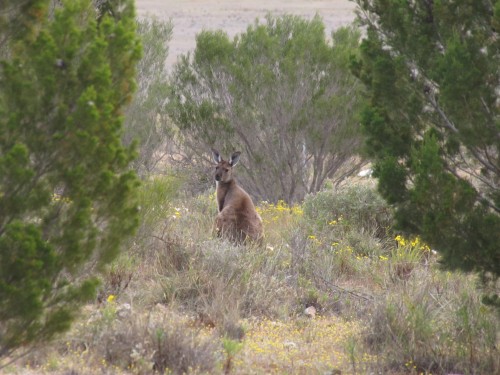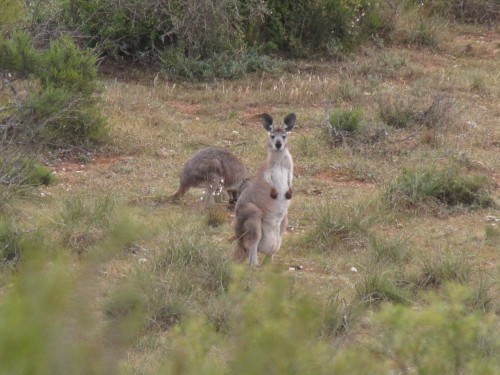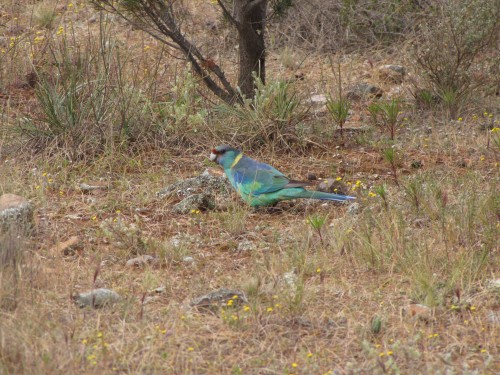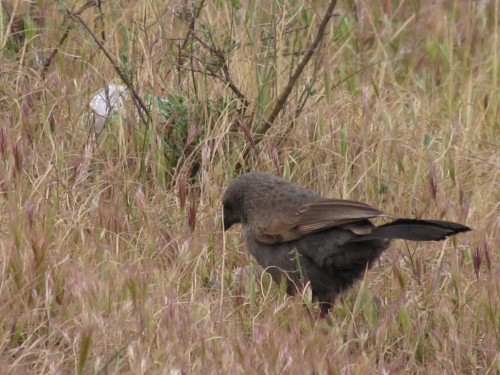Wildlife in the Greg Duggan Nature Reserve
Kangaroos
The wildlife in the Greg Duggan Nature Reserve in Peterborough, South Australia is quite diverse. Over recent weeks I have been sharing some of the wildflowers I photographed there in September last year. Despite being only 10 acres in size, the fauna is also quite interesting as well. When I visited a small mob of Western Grey Kangaroos was grazing contentedly on the grasses thriving in the park. The female in the photo below looks decidedly like there is a joey in her pouch.
Introduced Mammals
While I didn’t see any other mammals on this visit apart from several rabbits there are sure to be also a few other introduced mammals in this reserve and nearby, including:
- Red Fox (common)
- Brown Hare (common)
- House Mouse (common)
- Black Rat
- Feral House Cat (widespread)
- Goat (present in large numbers further north in the Flinders Ranges)
- Fallow Deer (small feral populations in nearby Jamestown area)
Native Mammals
- Western Grey Kangaroo (common)
- Echidna (probably present in this area)
- Several Bat species (common)
- Brushtail Possum (possibly present)
Reptiles:
I am no expert in this field but there are many species of reptiles in the wildlife of this area, including:
- Snakes – the common species would be Brown Snakes, but there must be others
- Lizards – many species including Blue-tongues, Stumpy-tailed, geckos, skinks and so on
Insects:
Again, I am no expert in this field but I have casually observed a variety of
- butterflies (see photo below – I haven’t been able to identify this one)
- moths
- grasshoppers
- many kinds of beetles, bugs and native cockroaches, to name only a few.
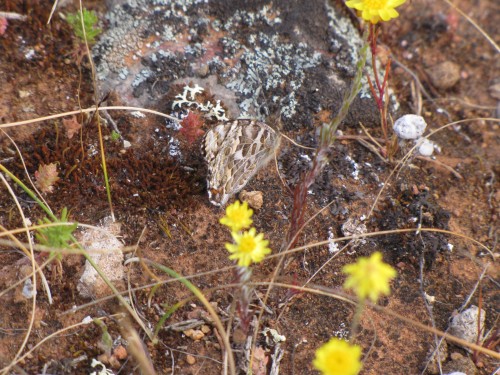
Butterfly or moth? (Hard to see – it is right in the middle of the photo just above the two flowers)
Birds:
This is one area of wildlife where I do have a great deal of knowledge in this area. In all, there are probably well over 150 different species of birds in the region – say, within a 20km radius. Included in this list are a few waterbirds (present in dams and a wetland area near the caravan park), eagles, hawks, pigeons, many species of honeyeaters, chats, babblers, parrots, thornbills, magpies, ravens, woodswallows, finches and the list goes on.
I have included only two photos today (see below). Of special note is the Apostlebird, an uncommon species in South Australia. The township of Peterborough has several large family groups of this species and is one of only a handful of places in the state where they can be reliably seen. The are very common in the eastern states, however.
Kangaroos, Pondalowie Bay, Yorke Peninsula
Just as we were leaving the camping grounds at Pondalowie Bay we came across a small mob of Western Grey Kangaroos right next to the road. Being in the Innes National Park this would be quite a normal sighting. In fact, this group was not at all perturbed by our car just a few metres away as they are quite used to vehicles moving through the park every day. During the summer months vehicles probably pass this way every few minutes.
Various forms of kangaroos and wallabies abound in rural Australian regions (pun intended). They are a hazard to fast moving vehicles on country roads, especially at night when they tend to come out to graze. I have experienced first hand the damage a ‘roo can do to a car with no protective bars. The damage is not only to the car; many hundreds, perhaps thousands of kangaroos and wallabies become road kill statistics every year. Sad but true.
As we drove back to our motel in the dusk that evening I slowed done. I didn’t want to add to those statistics.
Kangaroos, Monarto Zoo, South Australia
On our bus tour of Monarto Zoo last year I managed to get these photos of several kangaroos. The Western Grey Kangaroo was carrying a joey in the pouch (see above). Below is a shot of a large Red Kangaroo.
When the zoo was opened to the public in 1993 the area was enclosed by a tall fence. Some kangaroos native to this area were trapped inside the fence and have continued to thrive, albeit not in the enclosures housing the cheetahs and lions!
